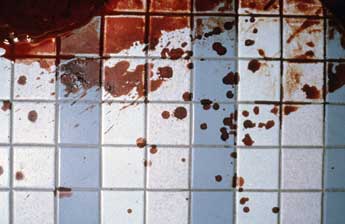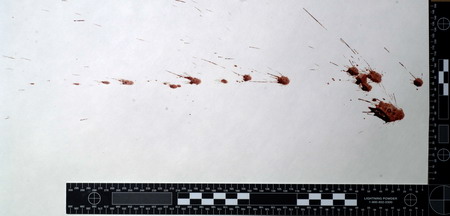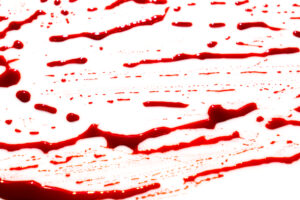How To Collect Blood Stain Evidence
Wear new unused clean latex or nitrile gloves respiratory protection and eye protection. Collecting fluid almost always involves the use of a swab applied to the visible portion of a piece of evidence.

Crime Scene And Evidence Photography Evidence Photography At The Crime Scene
Collect the entire item bearing the.
How to collect blood stain evidence. Question that proper collection and preservation of blood is a technique that every forensic investigator and scientist must learn to master 1-15. Refrigerate liquid blood samples do not freeze. Do not smear a small stain over a large surface.
To collect liquid blood. A cotton swab or Q-tip is moistened with saline solution and then dipped into or gently rubbed over the surface of the sample to be collected. A completed saturated spot will contain 100 µl of blood.
Liquid blood evidence is generally collected from blood pools but can be collected off of clothing as well using a. Too often we are faced with cases where the improper collection or testing of a blood sample can make the interpretation of the blood evidence difficult or. Photograph the blood and its location.
Working quickly hold the filter paper by the edges and touch the filter paper gently against the large drop of blood and in one step allow a sufficient quantity of blood to soak through and completely fill or saturate a circle. Officers should collect wet blood as a stain on a piece of air-dried clean white cloth that has been thoroughly rinsed to remove soap. To keep the stain concentrated collect the stain on the smallest area of the swab or cotton cloth.
A pool of wet blood on an immovable surface like a tile floor can be collected. Because of the attached wooden applicator stick cotton swabs are easiest to use tweezers are not needed. Liquid and dried blood.
Photograph spatters stains and drops in both wide angle. 2 mm size bloodstain may need special handling. Collecting Blood Evidence If the item is small and transportable then package it in a paper bag or plastic bag to prevent contamination of other objects.
Air-dry all wet blood and other body fluid stains on evidence items do not subject to heat. There are two different types of blood that can be collected at a crime scene. Of garments with blood or seminal stains.
Swabbing for Blood and Other Fluids Swabbing for blood or other fluids and collecting trace evidence are two totally different swab games. Each item should be initialed and dated In an area away form the stain. The stain is transferred to the adhesive side of the tape which may then be secured on a.
Of free flowing blood to collect at the puncture site. Metal or glass items should be stored at room temperature and submitted to the laboratory as soon as possible. It is then sealed in an evidence envelope or tube and documented.
Officers should allow wet blood stains found on clothing or other transportable. Wear new unused clean latex or nitrile gloves respiratory and eye protection. He uses green check hemisticks luminol and bluestar to locate blood.
To collect bloodstains from substrates. Evidence collection materials such as envelopes bags etc. But collecting trace evidence isnt always as straightforward.
Photograph the bloodstain and the item bearing the bloodstain. The collection and preservation of blood stain evidence is important because this evidence can be used to type blood or run DNA analysis. Collection procedure before collecting blood samples at a crime scene.
Evidence from the suspect and. Will dictate how youpackage and log hairs and fibers. Bring it to a secured location take it out of the bag and allow the evidence and the bag to thoroughly air dry.
The fingerprint-lifting tape may be placed over the stain and lifted off. Mike demonstrates how to use preliminary blood tests at a crime scene. Thus use a small part of a swab or a small piece of gauze to collect a small stain.
The size of the stain should influence the size of a substrate used to collect the stain. Use a minimum amount of distilled water to dampen the swab or clothgauze substrate. Swabbing for Trace Evidence vs.
Swabbing is the most common technique used to collect various samples of DNA evidence. Until submission to the crime laboratory freeze all stained items except for any metal or glass items eg. All items should be sealed and labeled for identification per your department policy.
An optional method for collecting dried blood stains on a nonabsorbent surface is using fingerprint tape. Small biological evidence stains eg. Photograph spatters stains and drops in both wide angle and closeup.

Forensic Science Bloodstain Pattern Analysis

Bloodstain Pattern Analysis An Overview Sciencedirect Topics

Bloodstain Pattern Analysis An Overview Sciencedirect Topics

Blood 5 Transfer Bloodstains Crime Scene
Blood Pattern Analysis Coroner Talk

Bloodstain Pattern Analysis An Overview Sciencedirect Topics

Blood Evidence Blood Stain Pattern Analysis Crime Museum

Bloodstain Pattern Analysis Principles Principles Analysis Bodily Injury

Pin On Forensic Science Institute Training Center

Bloodstain Pattern Analysis The Forensics Library

Bloodstain Pattern Analysis An Overview Sciencedirect Topics

Blood 5 Transfer Bloodstains Crime Scene

Bloodstain Pattern Analysis An Overview Sciencedirect Topics

Pin On Forensic Courses Criminal Investigation Sifs In



